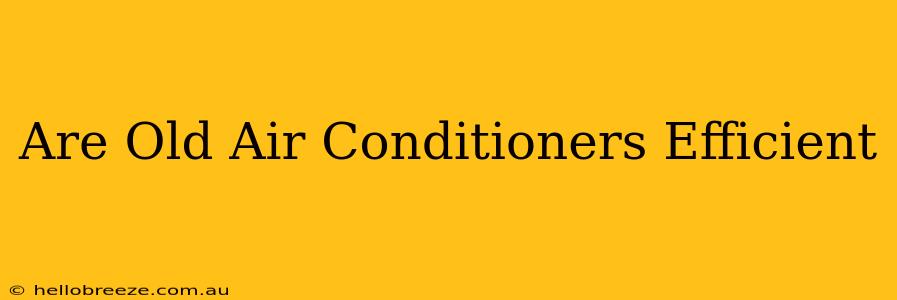Are Old Air Conditioners Efficient? Understanding the Energy Costs of Older AC Units
Are you still using an old air conditioner? While nostalgia might have its charms, clinging to an outdated AC unit can significantly impact your energy bills and environmental footprint. This article dives into the efficiency of older air conditioners compared to their modern counterparts, helping you determine if it's time for an upgrade.
The Inefficiency of Older AC Units
Older air conditioners, particularly those manufactured before the widespread adoption of energy-efficient standards, are notorious for their energy guzzling habits. Here's why:
- Outdated Technology: Older models lack the advanced compressor technology and sophisticated controls found in newer units. These advancements drastically improve cooling efficiency.
- Refrigerant: Many older AC units utilize refrigerants that are not only less efficient but also harmful to the environment. Modern refrigerants are significantly more environmentally friendly and contribute to improved energy performance.
- Higher Energy Consumption: The result of outdated technology and refrigerants is a substantially higher energy consumption rate. This translates directly to a larger electricity bill each month.
- Increased Wear and Tear: Older units are more prone to breakdowns and require more frequent repairs, adding further costs to your budget. These repairs often outweigh the cost savings of keeping the old unit.
- Poor Cooling Performance: While initially seemingly functional, older AC units often struggle to adequately cool your space, leading to discomfort and increased energy usage as the unit struggles to compensate.
Comparing SEER Ratings: A Key Indicator of Efficiency
The Seasonal Energy Efficiency Ratio (SEER) is a crucial metric to understand when evaluating air conditioner efficiency. SEER measures the cooling output (in BTU) per watt of electricity consumed over a typical cooling season. The higher the SEER rating, the more efficient the unit.
- Older AC Units (pre-2006): Often had SEER ratings below 10.
- Modern AC Units: Typically boast SEER ratings of 14 or higher, with some high-efficiency models reaching 20 or more.
This significant difference in SEER rating directly translates to substantial energy savings. A higher SEER rating means you'll pay less for electricity while enjoying better cooling performance.
The Environmental Impact
Beyond the financial implications, using an old, inefficient air conditioner has significant environmental consequences. The older refrigerants used in these units contribute to ozone depletion and global warming. Upgrading to a newer, environmentally friendly model helps reduce your carbon footprint and contribute to a healthier planet.
Is it Time to Replace Your Old Air Conditioner?
If your air conditioner is more than 10-15 years old, it's likely time to consider a replacement. The long-term savings on energy bills, coupled with the environmental benefits and improved comfort, often outweigh the initial investment of a new, energy-efficient unit.
Consider these factors when making your decision:
- Your current energy bills: Are they unusually high?
- The age of your unit: Is it showing signs of age and wear?
- The frequency of repairs: Are you constantly calling for repairs?
- Your comfort level: Is your home adequately cooled?
By carefully weighing these factors, you can make an informed decision about whether to keep your old air conditioner or invest in a more efficient model. The long-term benefits will undoubtedly justify the upgrade.

